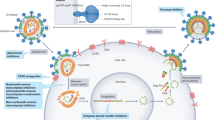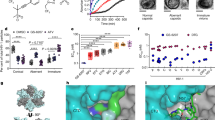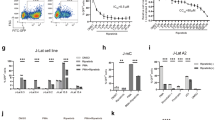Abstract
Highly active antiretroviral therapy (HAART) treatment for HIV has changed the course of AIDS in societies in which the drugs are readily available. Despite the great success of HAART, drug resistance and toxicity issues still remain a concern for some individuals. Thus, a number of investigators have been exploring other approaches for inhibiting HIV-1 replication. One of the most potent of these is the use of RNA interference (RNAi). This review will focus solely on the use of RNAi for the treatment of HIV-1 infection, including the problems, progress and future prospects.
This is a preview of subscription content, access via your institution
Access options
Subscribe to this journal
Receive 12 print issues and online access
$259.00 per year
only $21.58 per issue
Buy this article
- Purchase on Springer Link
- Instant access to full article PDF
Prices may be subject to local taxes which are calculated during checkout


Similar content being viewed by others
References
Fire A, Xu S, Montgomery MK, Kostas SA, Driver SE, Mello CC . Potent and specific genetic interference by double-stranded RNA in Caenorhabditis elegans. Nature 1998; 391: 806–811.
Zamore PD . RNA interference: big applause for silencing in Stockholm. Cell 2006; 127: 1083–1086.
Castanotto D, Rossi JJ . The promises and pitfalls of RNA-interference-based therapeutics. Nature 2009; 457: 426–433.
Kim DH, Rossi JJ . Strategies for silencing human disease using RNA interference. Nat Rev Genet 2007; 8: 173–184.
de Fougerolles A, Vornlocher HP, Maraganore J, Lieberman J . Interfering with disease: a progress report on siRNA-based therapeutics. Nat Rev Drug Discov 2007; 6: 443–453.
Kurreck J . RNA interference: from basic research to therapeutic applications. Angew Chem Int Ed Engl 2009; 48: 1378–1398.
Zamore PD, Tuschl T, Sharp PA, Bartel DP . RNAi: double-stranded RNA directs the ATP-dependent cleavage of mRNA at 21 to 23 nucleotide intervals. Cell 2000; 101: 25–33.
Song E, Lee SK, Wang J, Ince N, Ouyang N, Min J et al. RNA interference targeting Fas protects mice from fulminant hepatitis. Nat Med 2003; 9: 347–351.
Scherer L, Rossi JJ, Weinberg MS . Progress and prospects: RNA-based therapies for treatment of HIV infection. Gene Therapy 2007; 14: 1057–1064.
Singh SK, Gaur RK . Progress towards therapeutic application of RNA interference for HIV infection. BioDrugs 2009; 23: 269–276.
Haasnoot J, Westerhout EM, Berkhout B . RNA interference against viruses: strike and counterstrike. Nat Biotechnol 2007; 25: 1435–1443.
Boden D, Pusch O, Lee F, Tucker L, Ramratnam B . Human immunodeficiency virus type 1 escape from RNA interference. J Virol 2003; 77: 11531–11535.
Das AT, Brummelkamp TR, Westerhout EM, Vink M, Madiredjo M, Bernards R et al. Human immunodeficiency virus type 1 escapes from RNA interference-mediated inhibition. J Virol 2004; 78: 2601–2605.
Pusch O, Boden D, Silbermann R, Lee F, Tucker L, Ramratnam B . Nucleotide sequence homology requirements of HIV-1-specific short hairpin RNA. Nucleic Acids Res 2003; 31: 6444–6449.
Rossi JJ, June CH, Kohn DB . Genetic therapies against HIV. Nat Biotechnol 2007; 25: 1444–1454.
Richman DD, Margolis DM, Delaney M, Greene WC, Hazuda D, Pomerantz RJ . The challenge of finding a cure for HIV infection. Science 2009; 323: 1304–1307.
Tsygankov AY . Current developments in anti-HIV/AIDS gene therapy. Curr Opin Investig Drugs 2009; 10: 137–149.
Podlekareva D, Mocroft A, Dragsted UB, Ledergerber B, Beniowski M, Lazzarin A et al. Factors associated with the development of opportunistic infections in HIV-1-infected adults with high CD4+ cell counts: a EuroSIDA study. J Infect Dis 2006; 194: 633–641.
Li MJ, Kim J, Li S, Zaia J, Yee JK, Anderson J et al. Long-term inhibition of HIV-1 infection in primary hematopoietic cells by lentiviral vector delivery of a triple combination of anti-HIV shRNA, anti-CCR5 ribozyme, and a nucleolar-localizing TAR decoy. Mol Ther 2005; 12: 900–909.
Brass AL, Dykxhoorn DM, Benita Y, Yan N, Engelman A, Xavier RJ et al. Identification of host proteins required for HIV infection through a functional genomic screen. Science 2008; 319: 921–926.
König R, Zhou Y, Elleder D, Diamond TL, Bonamy GM, Irelan JT et al. Global analysis of host-pathogen interactions that regulate early-stage HIV-1 replication. Cell 2008; 135: 49–60.
Zhou H, Xu M, Huang Q, Gates AT, Zhang XD, Castle JC et al. Genome-scale RNAi screen for host factors required for HIV replication. Cell Host Microbe 2008; 4: 495–504.
Goff SP . Knockdown screens to knockout HIV-1. Cell 2008; 135: 417–420.
ter Brake O, t Hooft K, Liu YP, Centlivre M, von Eije KJ, Berkhout B . Lentiviral vector design for multiple shRNA expression and durable HIV-1 inhibition. Mol Ther 2008; 16: 557–564.
Whitehead KA, Langer R, Anderson DG . Knocking down barriers: advances in siRNA delivery. Nat Rev Drug Discov 2009; 8: 129–138.
Berkhout B, ter Brake O . Towards a durable RNAi gene therapy for HIV-AIDS. Expert Opin Biol Ther 2009; 9: 161–170.
Kumar P, Ban HS, Kim SS, Wu H, Pearson T, Greiner DL et al. T cell-specific siRNA delivery suppresses HIV-1 infection in humanized mice. Cell 2008; 134: 577–586.
Song E, Zhu P, Lee SK, Chowdhury D, Kussman S, Dykxhoorn DM et al. Antibody mediated in vivo delivery of small interfering RNAs via cell-surface receptors. Nat Biotechnol 2005; 23: 709–717.
Peipp M, Küpers H, Saul D, Schlierf B, Greil J, Zunino SJ et al. A recombinant CD7-specific single-chain immunotoxin is a potent inducer of apoptosis in acute leukemic T cells. Cancer Res 2002; 62: 2848–2855.
Kwong PD, Wyatt R, Robinson J, Sweet RW, Sodroski J, Hendrickson WA . Structure of an HIV gp120 envelope glycoprotein in complex with the CD4 receptor and a neutralizing human antibody. Nature 1998; 393: 648–659.
Posner MR, Hideshima T, Cannon T, Mukherjee M, Mayer KH, Byrn RA . An IgG human monoclonal antibody that reacts with HIV-1/GP120, inhibits virus binding to cells, and neutralizes infection. J Immunol 1991; 146: 4325–4332.
Kim SS, Peer D, Kumar P, Subramanya S, Wu H, Asthana D et al. RNAi-mediated CCR5 silencing by LFA-1-targeted nanoparticles prevents HIV infection in BLT mice. Mol Ther 2010; 18: 370–376.
Neff CP, Zhou J, Remling L, Kuruvilla J, Zhang J, Li H et al. An aptamer-siRNA chimera suppresses HIV-1 viral loads and protects from helper CD4(+) T cell decline in humanized mice. Sci Transl Med 2011; 3: 66ra66.
Zhou J, Swiderski P, Li H, Zhang J, Neff CP, Akkina R et al. Selection, characterization and application of new RNA HIV gp 120 aptamers for facile delivery of Dicer substrate siRNAs into HIV infected cells. Nucleic Acids Res 2009; 37: 3094–3109.
Zhou J, Li H, Li S, Zaia J, Rossi JJ . Novel dual inhibitory function aptamer-siRNA delivery system for HIV-1 therapy. Mol Ther 2008; 16: 1481–1489.
Wheeler LA, Trifonova R, Vrbanac V, Basar E, McKernan S, Xu Z et al. Inhibition of HIV transmission in human cervicovaginal explants and humanized mice using CD4 aptamer-siRNA chimeras. J Clin Invest 2011; 121: 2401–2412.
Hussey RE, Richardson NE, Kowalski M, Brown NR, Chang HC, Siliciano RF et al. A soluble CD4 protein selectively inhibits HIV replication and syncytium formation. Nature 1988; 331: 78–81.
Sattentau QJ, Moore JP . The role of CD4 in HIV binding and entry. Philos Trans R Soc Lond B Biol Sci 1993; 342: 59–66.
Dalgleish AG, Beverley PC, Clapham PR, Crawford DH, Greaves MF, Weiss RA . The CD4 (T4) antigen is an essential component of the receptor for the AIDS retrovirus. Nature 1984; 312: 763–767.
Kraus E, James W, Barclay AN . Cutting edge: novel RNA ligands able to bind CD4 antigen and inhibit CD4+ T lymphocyte function. J Immunol 1998; 160: 5209–5212.
Hütter G, Nowak D, Mossner M, Ganepola S, Müssig A, Allers K et al. Long-term control of HIV by CCR5 Delta32/Delta32 stem-cell transplantation. N Engl J Med 2009; 360: 692–698.
Robbins MA, Li M, Leung I, Li H, Boyer DV, Song Y et al. Stable expression of shRNAs in human CD34+ progenitor cells can avoid induction of interferon responses to siRNAs in vitro. Nat Biotechnol 2006; 24: 566–571.
DiGiusto DL, Krishnan A, Li L, Li H, Li S, Rao A et al. RNA-based gene therapy for HIV with lentiviral vector-modified CD34(+) cells in patients undergoing transplantation for AIDS-related lymphoma. Sci Transl Med 2010; 2: 36ra43.
Berkhout B . Toward a durable anti-HIV gene therapy based on RNA interference. Ann NY Acad Sci 2009; 1175: 3–14.
Berkhout B, Sanders RW . Molecular strategies to design an escape-proof antiviral therapy. Antiviral Res 2011; 92: 7–14.
Liu YP, Berkhout B . Lentiviral delivery of RNAi effectors against HIV-1. Curr Top Med Chem 2009; 9: 1130–1143.
Acknowledgements
This work was supported by grants from the National Institutes of Health to JJR: AI29329, AI42552 and HL07470
Author information
Authors and Affiliations
Corresponding author
Ethics declarations
Competing interests
The authors declare no conflict of interest.
Rights and permissions
About this article
Cite this article
Zhou, J., Rossi, J. Current progress in the development of RNAi-based therapeutics for HIV-1. Gene Ther 18, 1134–1138 (2011). https://doi.org/10.1038/gt.2011.149
Received:
Revised:
Accepted:
Published:
Issue Date:
DOI: https://doi.org/10.1038/gt.2011.149
Keywords
This article is cited by
-
Editing out HIV: application of gene editing technology to achieve functional cure
Retrovirology (2021)
-
Innate and adaptive resistance to RNAi: a major challenge and hurdle to the development of double stranded RNA-based pesticides
3 Biotech (2021)
-
The therapeutic landscape of HIV-1 via genome editing
AIDS Research and Therapy (2017)
-
Development of Lentiviral Vectors Simultaneously Expressing Multiple siRNAs Against CCR5, vif and tat/rev Genes for an HIV-1 Gene Therapy Approach
Molecular Therapy - Nucleic Acids (2016)
-
Protein and oligonucleotide delivery systems for vaginal microbicides against viral STIs
Cellular and Molecular Life Sciences (2015)



